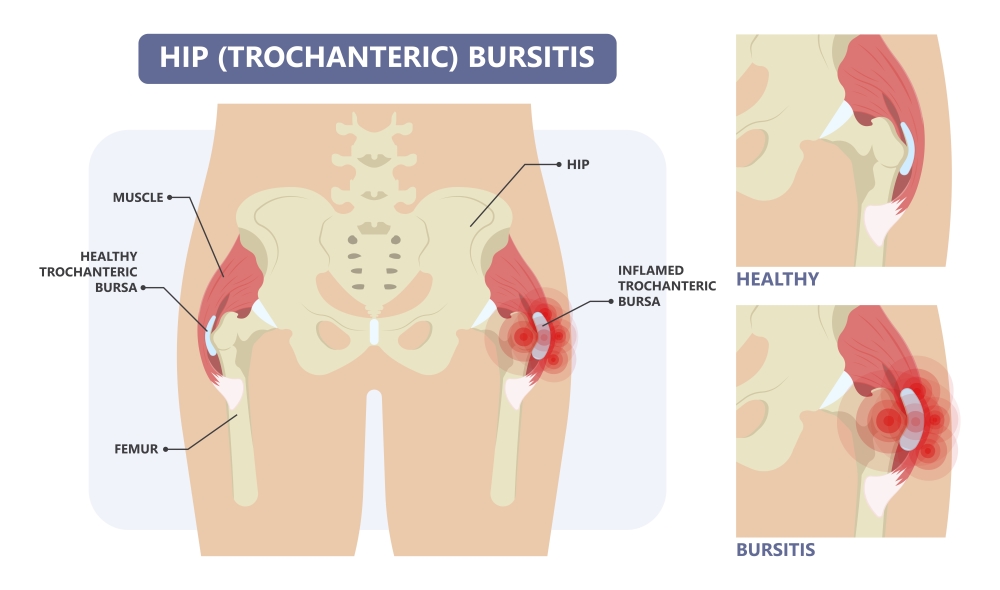Our hip joints are one the largest and strongest in our body. They provide strength and flexibility during walking, running, and jumping. However, the hip joints can take a beating, leading to pain. One of the most common causes of hip pain is hip tendonitis. We often call this problem greater trochanteric pain syndrome. It is also called trochanteric tendonitis or bursitis and is common and readily treatable. How do we treat greater trochanteric pain, and is a trochanteric bursitis injection helpful?

What causes greater trochanteric pain syndrome?
This condition occurs primarily from an overuse injury to the tendons outside the hip. Adults who walk, run or play sports are likelier to get this injury. Moreover, women are more likely to suffer from this injury than men, perhaps related to the shape of a woman’s pelvis. Other causes include a muscle or tendon tear, a fall onto the outside of your hip, or acute inflammation such as rheumatoid arthritis. Finally, weakness of the hip muscles is an essential factor.
Gluteal pain is twice as likely in women, with a higher rate in older women.
A recent study found that those people who developed hip tendonitis were more likely to develop hip arthritis. The reason why people with tendon pain are more likely to develop arthritis is unknown. However, we suspect that weakness of the buttock muscles can lead to tendon swelling and joint arthritis.
More significant trochanteric pain syndrome symptoms
Usually, you’ll first notice pain on the outside of your hip. Pain worsens when lying directly on your hip, walking up and down stairs, and prolonged walking and running. You may also get pain when crossing your legs. Moreover, the outside of your hip is tender to touch, and pain occurs when moving the leg outwards.
On occasion, people with gluteal pain can have significant night pain.
When examining a person with gluteal tendonitis, we perform specific tests, such as standing on the affected leg, step-ups on the affected side, and hitching manoeuvres on a step. Touching the side of the hip is painful. Lifting the leg from the side position reproduces outside hip pain. Often, people with gluteal tendinopathy have a significant side-raising weakness. In addition, a general hip and spine examination excludes other causes of pain outside the hip, such as hip arthritis or referred pain from the sacroiliac joint or lumbar spine.
Sometimes, further investigations, such as ultrasound or MRI, are needed to confirm the cause and rule out these other causes of hip pain.
Trochanteric bursitis ultrasound
Generally, investigations are needed if you’re not responding to therapy or present with unusual symptoms. Usually, ultrasound shows trochanteric tendonitis and bursitis. Sometimes, calcification or tendon tears can be seen. Just having trochanteric bursitis means you also have gluteal tendonitis.
An X-ray or MRI is helpful if we think hip pain is due to another cause, such as hip arthritis.
Greater trochanteric pain syndrome treatments
Greater trochanteric pain syndrome self-care
Most trochanteric tendonitis responds to simple treatments.
Firstly, lowering pressure on the hip tendons by not lying on the hip is helpful if the hip is irritable. A pillow between the knees to help keep the hips apart while sleeping helps. Also, avoid crossing your legs if you can. You should also limit stretching, such as a piriformis stretch.
Secondly, activities that irritate your hip abductor tendons should be reduced, such as prolonged walking or fast running. A practical example is reducing the step count to 50% of normal or reducing running intensity. You can use your phone to monitor step count. Keeping pain levels low (<3/10) is crucial in gluteal tendonitis.
Thirdly, it is helpful to take a short course of tablets, such as ibuprofen, for 1-2 weeks with other treatments.
Greater trochanteric pain syndrome exercises
It is essential to see a therapy expert to guide you through hip tendonitis exercises. Recent evidence suggests that exercises are better than no treatment or injections. These improvements start at eight weeks and last for at least 12 months.
Hip tendonitis exercises build muscle around the hip joint, including glutes, hip flexors and adductors. We often start with simple exercises such as side-lying hip raises, seated hip abduction with a band, and hamstring bridges with a band. As strength improves, it is vital to progress into standing exercises as quickly as possible,e such as step-ups on a box. Also, strengthening the quadriceps and calf muscles is essential. Generally, hip exercises are performed once per day.
Toward the end of rehab, adding exercises with high load and speed, such as a step-up with weight, is essential.
Soft tissue massage and acupuncture can sometimes help exercise in greater trochanteric tendonitis.
Occasionally, running assessment on a treadmill can detect subtle changes such as pelvic drop or cross-over gait. Reducing running stride and increasing cadence can reduce forces on the outside hip and help the management.
When do we start running again with greater trochanteric pain syndrome?
Once you develop some strength and the pain starts settling, we recommend hopping and jumping before running. These sessions should be added gradually 1-2x/week.
What happens if you get stuck?
Generally, other options are available in cases that don’t improve with physiotherapy.
Shockwave therapy uses sound waves directed to the painful tendons. Shockwave reduces pain by healing the tendon or stunning the small nerves, sending pain messages to the brain. Often, 3-5 sessions will help with the pain.
Evidence suggests that a series of shockwave treatments improve pain at six months.
Trochanteric bursitis injection
Alternatively, a trochanteric bursitis injection can suit some patients with hip tendonitis. Injections are helpful if your pain keeps you up at night or stops you from doing your rehab. But, again, there are different types of trochanteric bursitis injections.
Cortisone
Cortisone is a potent anti-inflammatory that reduces pain by lowering inflammation.
Research suggests cortisone injections for greater trochanteric pain syndrome are effective (but less so than exercise). In another study, pain improved six weeks after one cortisone injection and lasted for at least a year. In addition, the effects of cortisone are better in bursitis than tendonitis. However, we must be careful with cortisone injections due to potential side effects.
PRP
Recently, a new type of injection called PRP, or platelet-rich plasma, has been used for complex cases of trochanteric tendonitis. First, about 15-60 ml of whole blood is taken from a vein in the elbow. Next, we spin the blood down so the heavier red cells move to the bottom. Finally, plasma on top, which contains a high concentration of platelets and growth factors, is injected into the swollen tendons in your hip.
A good study suggests that a one-shot super-concentrated PRP improves pain and function after two years. So, the PRP formula is essential when considering PRP injection for greater trochanteric pain syndrome. We usually prefer a higher concentration of platelets. We like to use a second-generation PRP system that superconcentrates platelets, such as Arthrex ACP Max.
Needle tenotomy
This procedure involves repeated needling of the hip tendon using a low dose of a local anaesthetic. We think that the needling of a tendon causes acute inflammation, leading to the healing of trochanteric tendonitis. One study showed that needling improved pain from trochanteric tendonitis in about 80% of people after 2-3 months.
Generally, we suggest a trochanteric bursitis injection is done under ultrasound to improve accuracy. Therefore, you should only see a doctor with ultrasound-guided injection experience. It would help if you were wary of other practitioners, such as physiotherapists who inject but have much less experience.
Other frequently asked questions about greater trochanteric pain syndrome
How long does greater trochanteric pain syndrome last?
Like all tendonitis, gluteal tendonitis can cause pain that lasts for months. However, most people find that pain improves over time if they continue their exercises and rehab.
What if a cortisone shot doesn’t work for hip tendonitis?
Cortisone injections have been shown to improve pain after six weeks, and this effect lasts for up to a year. However, not all cortisone injections will work. We think that only 2/5 people get sustained relief from one shot.
In cases that fail a cortisone shot, we generally try other options. For example, shockwave therapy works for some people. Alternatively, we can use PRP injection. Typically, we recommend a one-shot superconcentrated PRP for greater trochanteric pain syndrome.
Gluteal tendon tear: Is the treatment any different?
Overall, gluteal tendon tears are more challenging to treat than gluteal tendonitis. However, the treatments are similar.
Generally, we start with exercise therapy. Other treatments we use are shockwave therapy and injections. One-shot superconcentrated PRP is particularly effective in partial tears. Finally, the gluteal tendon repair may be considered in cases where other treatments fail. Some surgeons perform keyhole surgery to reduce pain and hasten recovery.
Final word from Sportdoctorlondon about greater trochanteric pain syndrome
Greater trochanteric pain syndrome or trochanteric tendonitis is a common cause of hip pain. We suggest rehab first. If ineffective, then we recommend shockwave therapy or injections. If you’re thinking about an injection, choose a doctor with experience in injecting with ultrasound.



I received a corticosteroid injection in my left hip for bursitis. It worked great but in two weeks the pain was back again. What can be done to help?
Hi Jerome, I suggest physiotherapy. As discussed in the blog, shockwave therapy is a good addition. PRP injection if you fail other treatments.
I had a total right hip replacement 2 yrs ago and still have severe pain , bursitis , tendonitis, and I get sudden cramping in the right groin daily , ,, what should I do next ? My x ray shows that new hip is in place ?
Hi Joanne, Sorry to hear about your hip. While a hip replacement is an excellent operation, a minority have ongoing issues. In some cases, this pain may be due to hip flexor tendonitis. Please read this blog on psoas injections with a short reference to hip replacement.
https://sportdoctorlondon.com/iliopsoas-tendon-injection/
I think you’ve given me an idea for another blog.
All the best
Lorenzo
I’ve had outer hip pain for over a year now. I can’t lay on my hip at all for long periods of time and the pain keeps me up at night. I’ve had three cortisone shots but nothing lasts long enough. I’m in need of a good recommendation for an exercise routine or possibly the PRP injection but would like to know if it’s approved medically and if so, is it available in the US?
yes – both exercise and PRP injections have shown benefits. I’d avoid further cortisone injections. Yes PRP is available in the US. I’d suggest leucocyte rich PRP.
LM